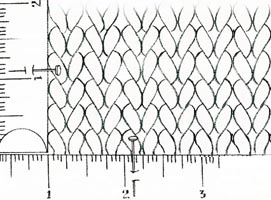On the YarnCraft podcast, our bi-weekly audio show, we cover topics from common questions to tips on gift ideas. In YarnCraft episode #15, we devoted the episode to answering questions sent in by listeners like you! My co-host Liz and I were joined by Jackie Smyth, technical editor here at Lion Brand, who helped us answer the following questions:
The answer to ALL of these questions is often gauge. Gauge will affect the size of your pattern; it will affect the way your fabric looks; wrong gauge can cause your fabric to misbehave and curl.
So what is gauge? Gauge is the term that is used to define the proper tension you should work your piece in order to make sure that your piece’s dimensions will match up to those specified in a pattern. It’s usually given as stitches by rows versus the measurement that they should create (say 18 sts by 24 rows over 4 by 4 inches).

To make a gauge swatch, knit or crochet a piece that’s at least 4 inches by 4 inches in the stitch specified by the gauge section of the pattern. Then compare your stitches and rows to the number specified by the pattern to make 4 inches in both directions. The key here is that you do NOT have to adjust how tightly you knit or crochet.
If you have too few stitches and rows, use a smaller hook/smaller needles and remake your swatch. If it’s correct, then you should use this new hook/needle size. If you have too many stitches/rows, go up a hook/needle size and remake your swatch. Again, if it’s now correct, then use this new needle/hook size. If it’s still too many stitches, adjust your needle/hook size again. For a more in-depth guide on gauge, visit our website for knit gauge and crochet gauge instructions.
For more tips, ideas, and inspiration from individual podcast episodes, visit the YarnCraft Podcast Blog.
Lion Brand Notebook
[…] have problems that can easily solved by checking gauge before starting the project–see my previous post for more info on gauge and its […]
the red handbag for mom. maybe. | Elle’s Crochet Corner
[…] learned about the importance of the use of gauge here! i normally do not enjoy bothering with gauge — in fact, i think i’ve only made a […]
Swatching: It’s Not Just for Gauge Anymore | Lion Brand Notebook
[…] doing this, we’re only short-changing ourselves. Not only can getting the proper gauge solve a number of problems, a gauge swatch can tell you much more than just whether you’re getting the requisite number of […]
Lilita
Yes, most of the time we are eager to start a new project and then we “miss” to swatch it; but I had many times, to repeat all the project due to differences found after missing to do the swatch, I learned the hard way to make the swatch first.
Lilita
the red handbag for mom. maybe. « UNRAVelleD
[…] learned about the importance of the use of gauge here! i normally do not enjoy bothering with gauge — in fact, i think i’ve only made a […]
Karen
What if I have 3 too many rows, but my sts are right on? I have a funny feeling I’ll have to knit another swatch- but if I go up a needle size, won’t this throw out the stitch count?
Zontee says: Hi Karen, generally speaking, the stitch count is what’s most important as the vast majority of patterns will tell you to knit (or crochet) to a specific length (e.g. Knit until piece is 7″ long). Because of this, you generally won’t have to count rows, and you can just knit less rows than the designer of the pattern to get the same length.
However, if you have a pattern that does tell you how many rows you need to knit, you may consider switching the material, but not the size, of your needles (e.g. switching from size 5 wood needles to size 5 plastic needles). Sometimes people find that wood, metal, plastic needles give them different tensions because of the varying slicknesses of the surfaces. Hope that helps!
Karen
Awesome! Thanks for the tips, Zontee- I’ll try that!
Eleanor
I have the opposite problem. My number of rows appears to be matching the gauge fine, but the number of stitches is not. My 25 stitches equal 5 inches instead of the 4 the gauge requires. I’m already working with a C hook – how much smaller can I go and still be able to see the stitches??? Also, won’t it also affect the height of the rows if I change to a smaller hook?
Gauge & Why It Matters | Lion Brand Notebook
[…] 5 Problems Solved by Gauge from YarnCraft Episode #15 […]